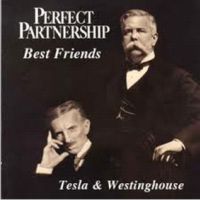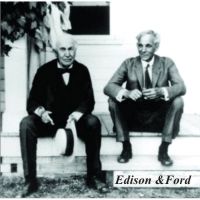|
Nikola Tesla
July 10, 1856 – January 7, 1943


|
Thomas Alva Edison
February 11, 1847 – October 18, 1931


|
|
He was an important contributor to
the birth of commercial electricity, and is best known
for his many revolutionary developments in the field of
electromagnetism in the late 19th and early 20th
centuries.
Tesla's patents and theoretical work
formed the basis of modern alternating current (AC)
electric power systems, including the polyphase system
of electrical distribution and the AC motor.
This work helped usher in the Second
Industrial Revolution.
He pioneered modern electrical
engineering and many of his discoveries were of
groundbreaking importance.
Tesla contributed in varying degrees
to the establishment of robotics, remote control, radar,
and computer science, and to the expansion of
ballistics, nuclear physics, and theoretical physics.
|
American inventor, scientist, and
businessman.
Edison is considered one of the most
prolific inventors in history, holding 1,093 US patents
in his name, as well as many patents in the United
Kingdom, France, and Germany. He is credited with
numerous inventions that contributed to mass
communication and, in particular, telecommunications.
These included a stock ticker, a
mechanical vote recorder, a battery for an electric car,
electrical power, recorded music and motion pictures.
His advanced work in these fields was an outgrowth of
his early career as a telegraph operator.
Edison originated the concept and
implementation of electric-power generation and
distribution to homes, businesses, and factories – a
crucial development in the modern industrialized world.
His first power station was on Manhattan Island, New
York.
|
|
Both were involved in science,
innovation, production and business. With different
priorities.
When Tesla was the first priority of invention and
science, then production and business.
When Edison vice versa: first profit,
and business, then production, and at the end of
innovation and science.
|
American joke
At age 28, Nikola Tesla arrived in
New York City.
Tesla handed Edison his letter of
recommendation: It read: "My Dear Edison: I know two
great men and you are one of them. The other is this
young man!"
Tesla proceeded to describe the
engineering work he had done, and his plans for an
alternating current motor.
Edison knew little of alternating current and did not
care to learn more about it. In short, AC power sounded
like competition to Edison. But there was something
different about Tesla, and Edison immediately hired him
to make improvements in his DC generation plants. Tesla
claimed that Edison promised him $50,000 if he
succeeded, perhaps thinking it an impossible
undertaking. But the potential of so much money appealed
mightily to the impoverished immigrant.
Both Tesla and Edison shared a common trait of genius in
that neither of them seemed to need much sleep. Edison
could go for days, taking occasional catnaps on a sofa
in his office. Tesla claimed that his working hours at
the Edison Machine Works were 10:30 a.m. till 5 a.m. the
next day. Even into old age Tesla said he only slept two
or three hours a night.
That's where the similarity ended. Tesla relied on
moments of inspiration, perceiving the invention in his
brain in precise detail before moving to the
construction stage. Edison was a trial and error man who
described invention as five percent inspiration and 95
percent perspiration. Edison was self-taught. Tesla had
a formal European education.
It was only a matter of time until their differences
would lead to conflict.
Several months after Edison employed him, Tesla
announced that his work was successfully completed. When
Tesla asked to be paid, however, Edison seemed
astonished. He explained that the offer of $50,000 had
been made in jest. "When you become a full-fledged
American you will appreciate an American joke," Edison
said.
Shocked and disgusted, Tesla
immediately resigned.
Word began to spread that a foreigner of unusual talent
was digging ditches to stay alive. Investors approached
Tesla and asked him to develop an improved method for
arc lighting. Although this was not the opportunity he
had hoped for, the group was willing to finance the
Tesla Electric Light Company. The proud new owner set to
work and invented a unique arc lamp of beautiful design
and efficiency. Unfortunately, all of the money earned
went to the investors and all Tesla got was a stack of
worthless stock certificates.
But his luck was about to change. Mr. A.K. Brown of the
Western Union Company, agreed to invest in Tesla's idea
for an AC motor. In a small laboratory just a short
distance from Edison's office, Tesla quickly developed
all the components for the system of AC power generation
and transmission that is used universally throughout the
world today. "The motors I build there," said Tesla,
"were exactly as I imagined them. I made no attempt to
improve the design, but merely reproduced the pictures
as they appeared to my vision and the operation was
always as I expected." The battle to produce his motor
was over. But the struggle to introduce it commercially
was only just beginning.
Downloaded from http://www.pbs.org
|


